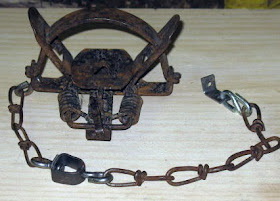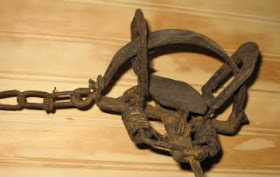This tutorial is to help guide new trappers through the trap preparation process. All pictures can be enlarged with a click.
When your new traps arrive, the first thing you have to do is remove the factory oil before attempting to apply a dye or wax. The wax and dye process not only prolongs the life of the trap but helps them to blend into natural surroundings. The wax acts as a lubricant and somewhat of a waterproofing for the trap. A waxed trap will fire faster than an untreated trap and will stay in operation longer in harsh conditions.
There are several methods commonly used for degreasing traps. The old method of boiling them in a lye solution is strongly discouraged because of the toxic vapors present with this process. Spraying them with a household degreaser and running them through the dishwasher or car wash can offer some great results. A cheap engine cleaner will work well but I prefer to spray mine with a dollar store oven cleaner and give them a good rinse with the hose.
Once the grease has been removed I make the necessary modifications. For muskrat trapping, little to no modifications are needed but adding swivels to any trap is always suggested. When targeting larger animals such as coyotes - modifications are strongly suggested to ensure the trap will stand up to extreme punishment and continue to restrain the animal in a humane manner without injuring the animal in case a non target specie needs to be released. Multiple swivels, shock springs and offset jaws all play an important role here. A trap chain without swivels will kink up and often result in an injured animal, and escape, or both.
This photo shows a basic raccoon trap with some simple modifications of an inline swivel and a drowning lock device.
This photo shows a fully modified trap for the serious canine trapper. 2 extra coil springs have been added, it has a solid steel base plate with D ring, jaw laminations, heavy duty chain, 3 swivels and a JC Conner shock spring.
Here are a few examples and explanations for specific trap modifications.
Jaw Lamination:
The Extra steel rod welded to the jaws of the trap reinforces the jaws and keeps them from bending and popping out of the trap frame. Some trappers add spots of weld to the jaw tips for extra protection.
Base Plates with D ring:
Base plates reinforce the trap frame and keep it from bending from the force of a jumping coyote and directs the force to the center of the trap frame - unlike the old style traps that had the chain attached to one corner of the trap.
The old style set up shown below directed all the force to one corner of the trap jaws often resulting in the jaws popping out of the frame and an empty trap left for the trapper.
After the modifications are finished most trappers like to ad a light coating of rust to the new traps. This helps the dye adhere to the new steel. Soaking your traps in salt water or a vinegar & water solution will speed up the rusting process. If vinegar is used you must wash the traps in a baking soda & water solution to halt the oxidizing process. Use caution with vinegar. If you soak your traps in straight vinegar for any length of time it will eat the steel and ruin them. Personally, I prefer NOT to pre-rust my new traps that are intended to be buried in a trap bed. My traps go straight to the dye pot immediately after the degreasing process. The last photo in this tutorial is of a bucket of brand new traps that were dyed and waxed without any surface rust.
The next step is to boil (or simmer) your traps in a dye solution. Log wood powder or crystals are most commonly used and preferred by canine trappers. Other (cold dip) methods are used such as Speed Dip or Formula one and even walnut hulls and other natural bark methods can be used.
Most logwood powders are best used at the ratio of one pound dye to 2.5 gallons of water.
Most supply houses offer logwood trap dye in convenient 1 pound packages such as this:
Simmering them for 20 to 40 minutes will offer great results on pre rusted traps. Brand new traps may take a few dunkings to obtain a black finish.
Letting the traps dry before applying the wax is recommended. If you plan to wax them immediately after dying, give them a good shake to remove the water from the traps. Water and hot wax is not a good combination.
You will get your best results with a high quality trap wax and avoid cheap paraffins. Most supply houses offer odorless trap wax in convenient 1 pound blocks. Black trap wax can also be found but necessary.
Some trappers add a few blocks of wax to the dye pot but your best results will come from dunking your traps in a bucket of hot wax. A tall narrow pot works best. The wider the pot = the more wax you will need. My waxing pot is tall and narrow measuring 9.5" wide and 10.5" tall. 10 pounds of wax will dye 2 traps at a time with full coverage.
Hot wax can be very flammable and this process is not recommended for an open fire or woodstove. A electric hot plate or propane camp stove works best. The wax process is as follows:
1. Insert a nail or screw between the jaws of the trap to allow wax to penetrate The entire trap. failure to do so will allow certain spots to rust and defeat the purpose.
2. Heat your wax till it just begins to lightly smoke. Continuous smoke means your wax is too hot. DO NOT burn your wax. This increases danger of fire and my effect the odor of your wax. Make sure you have a cover of some sort to extinguish your pot in case it catches fire. NEVER SPRAY WATER ON A WAX FIRE.
3. Wearing gloves, SLOWLY lower 1 or 2 traps into the hot wax so that they are TOTALLY submerged.
4. Let traps sit in wax until the trap steel has reached the temperature of the wax. This will offer you the best coating that will resist flaking off in cold weather.
5. With a hook of some sort, raise your traps from the wax and allow the excess to drip back into the pot before removing them entirely. Allowing spills to drip down the exterior of the pot to the flames can cause disaster.
6. Hang your traps to dry thoroughly.
7. Store your treated traps in a covered container to keep them free of foreign odors.
8. After your waxing job is finished, you can save your surplus wax for the following season. I just let mine harden in the pot, cover it and store it.
Some precautions to take when working with hot wax.
1. Hot wax is very flammable. The waxing process is safest to do outdoors if the weather permits. Do not wax in the rain because this will cause sputtering of hot wax and can cause burns.
2. Always have a cover handy to extinguish your pot in case it catches fire.
3. Wear gloves! If your pot sputters when you are attempting to lower traps into the wax and you burn yourself, you will most likely drop the traps and cause hot wax to splash and cause serious burns or start a fire. If a fire does occur, gloves may save your hands when trying to extinguish the fire in a panic.
Here is a bucket of brand new traps that are being stored until needed on the canine line. None of these traps were previously rusted and entered the dye pot immediately after the degreasing process.
I hope this answers your questions on trap preparation.














Thanks for the write up. Does anyone sell traps fully modified and ready to go?
ReplyDeleteHi Heath. I think more and more suppliers are starting to sell traps with modifications already done. Here's a link to some examples over at Kaatz Bros.
ReplyDeletehttp://www.kaatzbros.com/products.php?sub=190